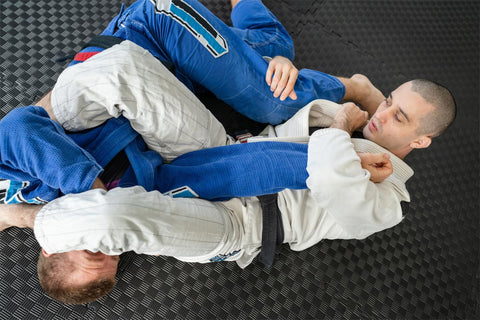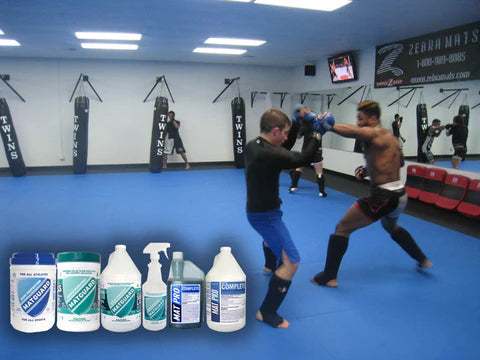
Jiu-Jitsu Rashes: How to Prevent Rashes
Brief Overview of Jiu-Jitsu as a Popular Martial Art and Its Physical Demands

Jiu Jitsu, a highly respected martial art and combat sport, has gained significant popularity worldwide for its effectiveness in self-defense and as a core component of mixed martial arts (MMA). This grappling-based art emphasizes ground fighting, submission holds, and techniques that allow a smaller person to defeat a larger opponent through leverage and technique. The physical demands of Jiu Jitsu training are intense. Requiring athletes to engage in close contact with their training partners and mats. Which is a breeding ground for various types of skin infections known as Jiu Jitsu rash.
Introduction to the Common Issue of Jiu Jitsu Rash
Jiu Jitsu rash encompasses several types of skin infections, including mat burn, fungal infections (such as ringworm), and bacterial infections (like staph). These rashes are not only uncomfortable and potentially unsightly but also pose a risk of spreading to training partners. Furhter highlighting the importance of awareness and prevention.
The Importance of Prevention and Treatment for Athletes
Preventing and treating Jiu Jitsu rash is crucial for athletes who want to continue training safely and effectively. Understanding the causes, symptoms, and treatments of these rashes is the first step in maintaining a healthy training environment and ensuring the well-being of all practitioners.
II. Understanding Jiu Jitsu Rash
Definition and Symptoms of Jiu Jitsu Rash
Jiu Jitsu rash refers to various skin conditions that can occur as a result of martial arts training. Symptoms can range from mild irritation and redness to severe infections that require medical intervention. It's essential for athletes to recognize these symptoms early to prevent the spread and worsening of the condition.
Different Types of Rashes Associated with Jiu Jitsu
- Mat Burn: Caused by friction between the skin and mats, mat burn appears as red, irritated patches, often on areas of the body that come into direct contact with the ground, such as knees, elbows, and the tops of feet. While generally mild, these abrasions can become gateways for more serious infections if not properly cared for.
- Fungal Infections (e.g., Ringworm): Ringworm, a common fungal infection in Jiu Jitsu athletes, spreads through skin-to-skin contact or contact with contaminated surfaces. It presents as circular, itchy, red patches on the skin, and is highly contagious.
- Bacterial Infections (e.g., Staph): Bacteria entering cuts or abrasions on the skin cause staph infections. Symptoms include painful, swollen areas on the skin, often filled with pus or other fluids. These infections can become severe and require immediate medical attention.
How These Rashes Affect Training and Overall Health
Jiu Jitsu rashes can significantly impact an athlete's ability to train, leading to missed sessions and hindering progress. More severe infections may result in systemic illness, requiring antibiotics or other medical treatments. Additionally, the communal nature of Jiu Jitsu means that an infected athlete poses a risk to others, underscoring the importance of prevention, early detection, and treatment of Jiu Jitsu rash for the health and safety of the entire training community.
III. Preventative Measures for Jiu Jitsu Rash
Preventing Jiu Jitsu rash is essential for anyone involved in the sport, from beginners to seasoned practitioners. Effective prevention involves a combination of personal hygiene, environmental precautions, and the appropriate choice of gear and clothing. Here's how athletes can protect themselves and their training partners from common skin infections.
Hygiene Practices
- Regular Washing of Gear and Uniforms: It's crucial to wash all Jiu Jitsu gear, including uniforms, rash guards, and spats, after every training session. This practice helps eliminate bacteria and fungi that can cause infections.
- Showering Immediately After Training Sessions: Highly recommend showering right after practice with antimicrobial soaps and body wash to remove bacteria and sweat that can lead to Jiu Jitsu rash.
- Using Antimicrobial Soaps and Body Wash: These products are formulated to kill bacteria and fungi on the skin, significantly reducing the risk of developing rashes.
- Using Matguard Antibacterial Body Wipes Before and After Each Practice or Fight: These antibacterial body wipes offer a convenient and effective way to clean the skin when a shower isn't immediately available, providing an additional layer of defense against skin infections.
Environmental Precautions

- Cleaning and Disinfecting Mats Regularly: Use Matguard’s EZ Pour for large-scale cleaning to ensure that all surfaces are sanitized effectively, reducing the risk of infection transmission.
- Using Matguard's Surface Spray and Surface Wipes for Daily Cleaning: For everyday maintenance, our surface spray and surface wipes can be used to quickly disinfect surfaces that come into frequent contact with athletes, such as mats, training equipment, and gym surfaces.
- Personal Hygiene Among All Practitioners in the Gym: Encouraging a culture of cleanliness within the gym helps to maintain a safe training environment. This includes regular handwashing, using personal towels, and avoiding the sharing of personal items.
Gear and Clothing
- Choosing the Right Type of Rash Guards and Spats: Selecting gear designed specifically for grappling can help prevent mat burn and skin infections. Look for materials that wick away moisture and fit snugly to minimize skin exposure.
- The Role of Breathable Fabrics in Preventing Rashes: Breathable fabrics help keep the skin dry and reduce the growth of bacteria and fungi. Gear made from these materials can significantly lower the risk of developing Jiu Jitsu rash.
- Cleaning Gear: Regular cleaning of all gear, not just clothing, is essential. This includes washing belts, knee pads, and any other equipment that comes into contact with your skin or the training surface.
By implementing these preventative measures, Jiu Jitsu practitioners can significantly reduce their risk of developing skin infections. Maintaining high standards of cleanliness protects not only the individual athlete but also their training partners and the broader Jiu Jitsu community.
IV. Treatment Options for Jiu Jitsu Rash

Dealing with Jiu Jitsu rash promptly and effectively is crucial for any practitioner's health and ability to continue training. Whether you're experiencing a minor irritation or a more severe infection, understanding your treatment options can help accelerate recovery and prevent the spread of infection to others. Here's a guide to the treatment options available for Jiu Jitsu rash.
First Aid and Home Remedies for Minor Rashes
- Clean the Affected Area: Gently wash the rash with soap and water to remove any bacteria or fungi.
- Cold Compress: Applying a cold compress can help reduce inflammation and soothe the skin.
- Over-the-Counter Antiseptic Creams: These can prevent infection and accelerate healing.
- Aloe Vera Gel: Known for its soothing properties, aloe vera can help relieve irritation and reduce redness.
When to See a Doctor: Identifying Signs of Infections
It's important to monitor your skin condition closely. Seek medical attention if you notice:
- Increased Pain, Swelling, Redness, or Warmth: These could be signs of a bacterial infection.
- Pus or Other Discharge: A clear indicator of infection that requires professional treatment.
- Fever: A fever may indicate that the infection has spread beyond the skin.
Medical Treatments
- Over-the-Counter (OTC) Medications and Creams for Fungal and Bacterial Infections: Antifungal creams and ointments can be effective for treating ringworm, while antibacterial creams are used for minor bacterial infections. It's essential to follow the application instructions carefully to ensure the best results.
- Prescription Medications for More Severe Cases: For more serious infections, a doctor may prescribe oral antibiotics or antifungal medications. Completing the full course of prescription medication is crucial, even if symptoms improve before the medication is finished.
Recovery and Return to Training: Guidelines to Follow to Avoid Recurrence
- Follow Doctor's Orders: Adhere strictly to any treatment plan prescribed by your healthcare provider.
- Rest and Recovery: Give your body time to heal before returning to training to prevent exacerbating the condition.
- Complete the Course of Medication: Even if you start feeling better, it's essential to finish all prescribed medication to ensure the infection is fully eradicated.
- Cleanliness: Continue practicing good hygiene, including washing all gear and clothing after each use and showering immediately after training.
- Inform Your Training Partners: If you've been diagnosed with a contagious skin infection, inform your training partners and take a break from training to prevent spreading the infection.
- Slow Return to Training: Gradually ease back into training, and consider wearing protective clothing to cover the affected area until fully healed.
By understanding and applying these treatment options for Jiu Jitsu rash, practitioners can ensure a safer and more comfortable return to their training routine, minimizing the risk of recurrence and promoting a healthy training environment for everyone involved.
V. Tips for Safe Training
Maintaining a safe training environment is essential for preventing Jiu Jitsu rash and ensuring that practitioners can train effectively without the risk of skin infections. Here are some key tips to help Jiu Jitsu athletes train safely and minimize the risk of developing or spreading skin conditions.
Importance of a Clean Training Environment
- Regular Cleaning of Mats and Equipment: Ensure that all mats and training equipment are cleaned and disinfected after each session to kill bacteria and fungi that can cause Jiu Jitsu rash.
- Air Quality and Ventilation: Good ventilation helps to reduce the humidity in the gym, which can otherwise promote the growth of fungi and bacteria.
- Personal Cleaning Supplies: Encourage the use of personal cleaning supplies, such as towels and soap, to prevent cross-contamination.
Personal Responsibility in Maintaining Hygiene
- Wash Hands and Feet Before and After Training: This simple practice can significantly reduce the transfer of germs.
- Do Not Share Personal Items: Personal items like towels, razors, and soap should not be shared among practitioners to avoid spreading infections.
- Cover Open Wounds: Any cuts or abrasions should be properly covered with a waterproof bandage to prevent exposure.
Recognizing Early Signs of Skin Infections and Taking Immediate Action
- Be Aware of Symptoms: Early signs of Jiu Jitsu rash may include itching, redness, and discomfort. Recognizing these symptoms early can prevent more serious infections.
- Seek Treatment Immediately: If you suspect a skin infection, it's crucial to seek treatment right away to prevent it from worsening or spreading to others.
- Inform Your Instructor: Let your instructor know about any potential skin infection so they can take appropriate measures to protect other students.
Safe Training Habits to Prevent Skin Abrasions and Cuts
- Wear Appropriate Gear: Wearing the proper gear, such as rash guards and spats, can protect your skin from the friction that causes mat burn and other abrasions.
- Mind Your Technique: Being mindful of your technique can help avoid unnecessary scrapes and bruises. Proper technique not only improves your skills but also reduces the risk of injury.
- Keep Nails Trimmed: Long nails can scratch and cut both you and your training partners. Further increasing the risk of skin infections.
By following these tips for safe training, Jiu Jitsu practitioners can significantly reduce their risk of developing Jiu Jitsu rash and other skin infections. Creating a culture of cleanliness and responsibility within the gym not only promotes a healthier training environment but also ensures that everyone can continue to enjoy the art of Jiu Jitsu safely and effectively.
To prevent and manage Jiu Jitsu rash, adopting strong hygiene and safety practices is key. Clean gear, timely showers, and a sanitized training space are crucial. Recognize and act on any rash signs early. By maintaining cleanliness and being proactive, we ensure a healthier training journey for everyone. Let's commit to these steps for uninterrupted Jiu Jitsu enjoyment. Lastly. use our disinfectant wipes for body to stay safe.




